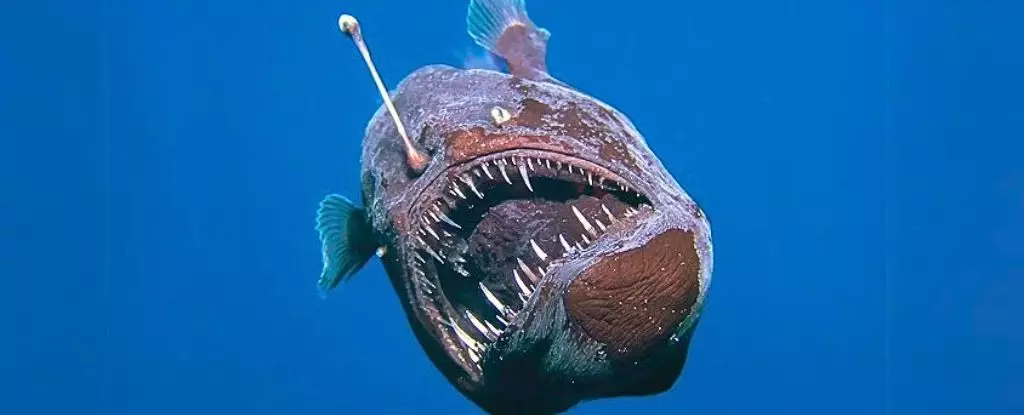In February, an extraordinary event unfolded off the coast of Tenerife, where researchers from Condrik Tenerife serendipitously captured footage of a humpback anglerfish (Melanocetus johnsonii) swimming in the sunlight. This species, colloquially known as the black seadevil, is generally relegated to the inky depths of the ocean—specifically between 200 to 600 meters. The fish was initially an elusive figure of maritime mythology, rarely documented in daylight. The recent footage not only unsettled our understanding of this deep-sea creature but also inspired a cultural spectacle across social media platforms, eliciting expressions of empathy and reflection that were wholly unexpected.
This unprecedented sighting is a paradigm shift in how we relate to marine life that has long been misrepresented as monsters lurking in the abyss. For many years, the deep sea has been seen as a terrifying domain—a place that inspires dread rather than curiosity. However, this remarkable incident has encouraged a cultural re-evaluation of our perceptions of the deep, revealing complex layers of empathy that transcend the boundaries between species.
A Feminist Icon?
The social media response to the anglerfish’s viscerality shines a light on a peculiar phenomenon: the anthropomorphization of a creature that is far removed from the everyday lives of most people. Some have hailed this fish as a feminist icon or likened its tragic journey to that of Icarus, who flew too close to the sun in his quest for enlightenment. This trend is fascinating, albeit perplexing. After all, what is it about a fish that evokes such strong cultural commentary?
While it may be tempting to dismiss these interpretations as mere fanciful musings, they represent a deeper societal yearning for connection with the natural world. The anglerfish’s poignant portrayal in this way invites us to question why we readily project human emotions onto non-human entities. Is it merely an exercise in creativity, or does it hint at a collective desire to find beauty and meaning in places we traditionally overlook? Symbols like the anglerfish could become a gateway for more profound discussions on themes such as environmentalism and feminism, despite the creature’s unconventional appearance and ecological role.
Exploring Human Curiosity and Responsibility
This anglerfish sighting has ignited a surge of interest in marine ecosystems, particularly among younger generations. As researchers and conservationists have noted, such enthusiasm is a double-edged sword. While public fascination can lead to increased awareness about marine conservation efforts, it can just as easily facilitate a naïve understanding of complex biological realities. Our tendency to assign romantic or humanistic narratives to oceanic inhabitants may obscure the urgent issues they face, such as biodiversity loss and climate change.
The anglerfish’s dramatic swim from the deep to the surface, resulting in her demise hours later, raises critical questions about whether we can balance our anthropocentric narratives with a genuine understanding of marine science. The fish’s last moments, observed and recorded by fascination-driven humans, sparked debates on nature’s whims versus human imposition. What acts of responsibility, if any, do we owe these enigmatic beings?
Beauty in ‘Monsters’
Historically portrayed as grotesque monsters of the unfathomable deep, anglerfish have been cultural touchstones in various forms of media, from horror films to animated features. Yet, the recent virality of the humpback anglerfish video showcases a societal shift towards recognizing—if not embracing—the beauty in what has been labeled monstrosity. It seems that we are gradually moving away from a binary view of “cute vs. ugly” in our appreciation of wildlife.
This reconsideration of perspective could be a revolutionary step in how future generations engage with natural life forms seen as “other.” The ability to empathize and connect with creatures that bear little resemblance to ourselves may pave the way for more inclusive and compassionate environmental policies, especially as we confront increasingly critical issues such as ocean pollution and habitat loss.
The Role of Media in Shaping Public Perception
The way the video of this anglerfish was disseminated and received indicates a subtle yet significant transformation in our relationship with deep-sea life. While the original intent was scientific observation, the social response has engendered a new cultural narrative around marine wildlife. Platforms such as Instagram, TikTok, and Reddit have effectively democratized science communication, allowing a cross-pollination of ideas that would have been inconceivable a decade ago.
However, with increased visibility comes the responsibility of critically engaging with the narratives that emerge. While the viral reception plays an essential role in fueling awareness, it can also foster misconceptions if the accompanying scientific knowledge is neglected. Just as the anglerfish has captivating characteristics, it also embodies a delicate ecosystem that humans have a responsibility to protect. How we engage with these discussions on social media may well define the trajectory of oceanic conservation efforts in the future.



Leave a Reply